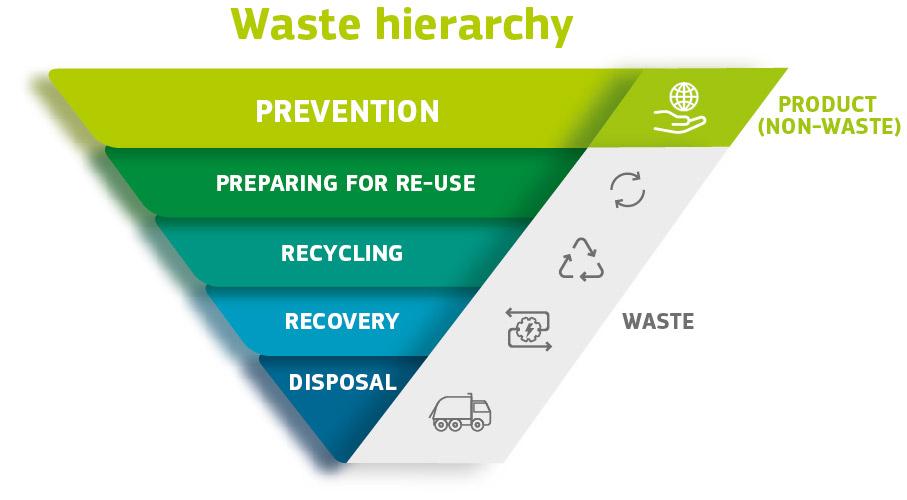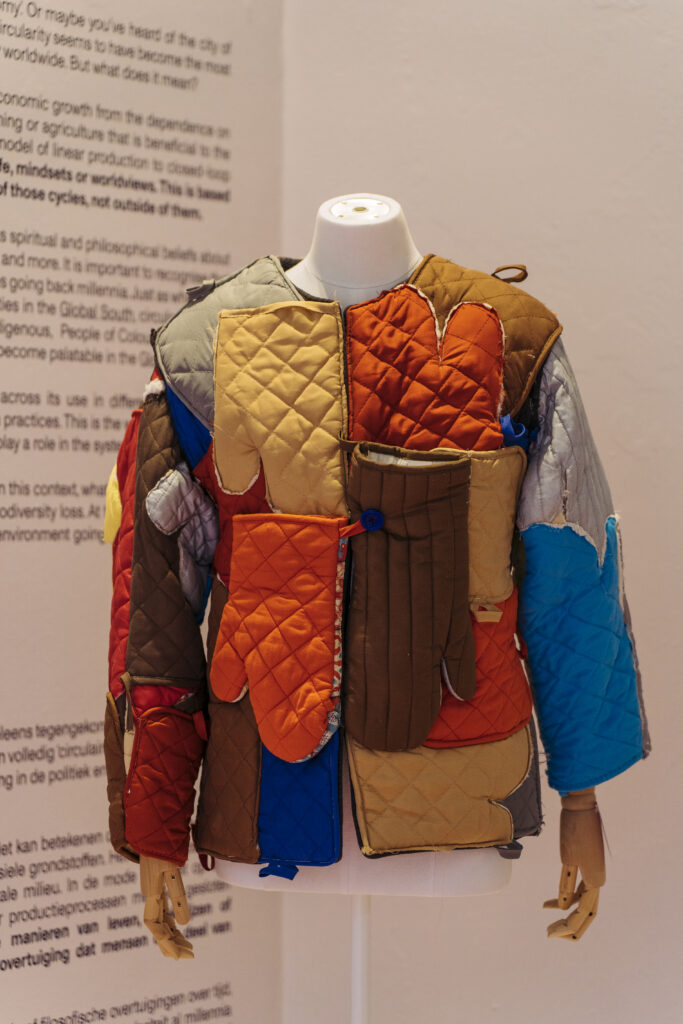What Happens Next? Your T-Shirt’s Journey Through Repair, Resale, and Recycling
Fashion for Good Exhibition, “What goes around comes around”.
Credits Elzo Bonam
12 August 2025
Do you remember that favourite tee that’s served you well through countless washes, weekend adventures, and lazy Sunday mornings? Now it’s eventually showing its age: maybe there’s a small tear near the hem, the colour has faded, or it’s simply lost its place in your regular rotation. But how can we give it a second chance? Rather than heading straight to the trash bin, your well-worn garment has several pathways ahead, each representing a different approach to circularity in our evolving fashion system.
Instead of the traditional linear model of make-use-dispose, these circular alternatives (repair, resale, and recycling) aim to keep clothing in use for as long as possible before materials are eventually returned to the system. This mirrors the EU’s waste hierarchy, a guiding framework that ranks waste management strategies by environmental impact: starting with prevention, then reuse (like repairing or reselling), followed by recycling, and finally disposal as the last resort. The goal is simple: keep resources in use at their highest value for as long as possible, reducing the need for virgin materials and the volume of waste sent to landfills or incineration.

Source: European Commission
FIXING YOUR FAVOURITES: WHY REPAIRING IS ALWAYS WORTH THE EFFORT
There’s something special about that t-shirt you reach for again and again. Maybe it’s the perfect shade of blue, the way it fits just right, or the memories attached to it. When wear and tear appear, repair is the simplest and most sustainable choice. Mending a seam or patching a hole extends a garment’s life without extensive new resources or processing, and often, it means holding onto something that still matters to you.
Overall, the repair landscape offers two main paths forward:
- DIY repair has found new life through online tutorials, community workshops, and the visible mending movement that transforms darning and patching into decorative arts. And most importantly: learning to fix your own clothes connects you to generations of people who knew that good things were worth preserving, and spoiler: it’s good for your wallet, too.
- Professional repair services offer another route. This can be of different types:
- Local tailors and seamstresses offer personalised repair services, often with expertise in specific garments or fabrics. Specialised organisations like SOJO and The Seam have emerged to fill this gap, connecting consumers directly with local makers (tailors, repair specialists) for alterations, repairs, and customisations, and digitising the process by creating user-friendly platforms that make professional repair services as convenient as ordering takeout.
- Brand initiatives, though they have been launched only by a few forward-thinking brands (like Patagonia’s “Worn Wear” programme and Levi’s Tailor Shops), have recognised that helping customers maintain their clothing builds deeper relationships than simply selling replacements. Organisations like United Repair Centre and MENDED are expanding this vision beyond individual brands, creating broader infrastructure for textile repair and restoration in collaboration with multiple brands. United Repair Centre combines circularity with social impact by providing training and employment opportunities to young adults and people with refugee backgrounds, while MENDED focuses on making professional repair services more accessible to consumers. The sell for brands is the extended customer loyalty and added potential revenue stream, although quite contested.
The barriers to widespread repair are real and stubborn: many consumers expect repair services to be free or very cheap, not accounting for the skilled labour involved, and without strong consumer demand, regulatory pressure, or clear profit potential, most brands view repair as a costly add-on rather than a core service worth investing in.
Most critically, while repair infrastructure exists through local tailors and alteration shops, several barriers prevent it from becoming mainstream: professional repairs often cost a significant portion of a garment’s original price, especially for inexpensive fashion, making replacement seem more economical. The process is also often perceived as inconvenient, requiring multiple trips and longer wait times compared to streamlined services like phone repair. But perhaps most importantly, throwaway culture has conditioned us as consumers to view clothing as disposable rather than worth repairing.

Look by Nicole McLaughlin. Credits Elzo Bonam
RESALE: ONE MAN’S TRASH IS ANOTHER MAN’S TREASURE
Remember when buying secondhand meant exclusively rummaging through musty thrift stores, hoping to strike gold? Those days are over: resale has transformed into fashion’s most exciting success story, where scoring a pre-loved designer piece feels like winning the lottery, and your wallet and the planet both thank you.
The numbers are already telling the story: Amazon reports Europe’s online resale market is worth €21.6 billion and is expected to grow by €2 billion in 2025, and in France, Vinted has actually overtaken traditional retailers to become the country’s top clothing destination. Think about that for a moment: more people are hunting for secondhand treasures than browsing the latest collections.
- Apps like Vinted, Depop, and Vestiaire Collective have fundamentally changed how we buy and sell pre-owned clothes. What once required trips to multiple thrift stores and yard sales can now happen from your phone, with search filters, size guides, and direct messaging making the process straightforward and efficient.
- Pioneering brands, like Patagonia, Levi’s, Zalando, H&M, Weekday and Zara (Inditex) have all launched their own platforms selling secondhand and unsold goods, seeing the potential of extending their products’ lifecycles and reducing waste, signalling a genuine shift toward more sustainable business models.
- That is where innovations like Trove step in: Trove provides white-label technology and end-to-end operations that power circular shopping for premium and luxury brands, providing the back-end technology, logistics, and reverse supply chain operations that make branded resale possible. This innovator enables brands to set up these platforms either as a separate page of their website or integrated into their main shop: by helping brands own and operate their own circular channels, Trove removes key friction points like product authentication, inventory management, and customer service, making it easier for companies to embrace secondhand as a core part of their business.
But it’s not all smooth sailing in secondhand paradise, and challenges still persist:
- Preconception around secondhand: While Gen Z embraces pre-owned fashion, many people still associate secondhand with lower quality or feel uncomfortable wearing someone else’s clothes. Brands and organisations are working to shift these attitudes through meaningful partnerships: one notable example is eBay becoming Love Island’s first pre-loved fashion partner, having reality TV stars wear second-hand items styled by celebrity stylist Amy Bannerman. This visibility helps normalise buying second-hand, but changing mass perception takes time.
- The trust game remains tricky: that “vintage” Chanel bag might be fake, and those “barely worn” jeans might have seen better decades. Despite improved verification systems and AI authentication, the fear of getting scammed still deters shoppers from higher-end resale. Innovations like The RealReal leverage machine learning not only to authenticate high-value goods like luxury bags, but also to predict which items require closer inspection, identify which are the most in demand, and determine best pricing, all contributing to greater efficiency, accuracy and buyer satisfaction.
- Each item is unique: every single garment needs to be photographed, described, stored, and shipped individually. Imagine running Amazon, but where every product is unique and unpredictable. There’s no bulk packaging, no standardised sizing, no identical inventory. It’s the complete opposite of traditional retail operations: while most retailers can produce thousands of identical items and ship them efficiently in bulk, resale platforms must handle each item as a one-off project. Quality assessment becomes crucial; Is that stain permanent or just a trick of the lighting? Will those vintage jeans fit like the measurements suggest? Storage becomes a puzzle of different sizes, seasons, and conditions rather than neat, predictable rows of identical products.
ThredUP provides a great solution to this: the company can process up to 100,000 garments each day, but each one requires individual attention: professional photography, detailed descriptions, quality assessment, and individual storage. ThredUP professionally photographs items, writes copy, packs and ships items, and manages returns for every single piece, turning what should be a simple transaction into a complex logistical operation.
This individual attention is both resale’s charm and its biggest operational challenge. Staff time multiplies exponentially: what takes minutes for new inventory takes hours for pre-owned pieces. That’s why every sustainable success story in resale is also a masterclass in complex operations management.

Source: Ambercycle
RECYCLING: THE FRONTIER THAT’S STILL UNDER CONSTRUCTION
When repair isn’t possible and resale isn’t viable, recycling represents your t-shirt’s last chance at a second life. In theory, textile recycling sounds straightforward: break down old clothes into new materials, but in practice, it is challenging to implement recycling at scale.
Challenge 1. Blends & contamination: the challenges start with the garments themselves. That soft cotton-polyester blend t-shirt that feels so comfortable? It’s likely a nightmare to recycle. Most textiles are made from mixed fibres and treated with dyes and chemical finishes, leading to contamination that complicates recycling. Especially in mechanical recycling, where fabrics are shredded into new fibres, these mixed inputs often result in lower-quality outputs. Your high-quality cotton t-shirt might be turned into insulation or stuffing, not another T-shirt. It’s recycling, but often it’s also downcycling. Meanwhile, innovators like Infinited Fiber Company, Ambercycle, Circulose, Syre, and Circ are pioneering chemical recycling methods that go beyond shredding. Their technologies break down fibres, separate blended fibres and remove contaminants like dyes, and regenerate high-quality textile materials that can be used to make new garments, aiming to close the loop on fashion waste.
Challenge 2. Sorting as another critical bottleneck: unlike uniform materials such as glass or aluminium, textiles come in countless blends (cotton-polyester, elastane-infused denim, wool-acrylic) and accurately identifying these compositions is essential to ensure effective recycling. Yet, in most recycling facilities, sorting is still done manually: a slow, inconsistent, and labour-intensive process. That’s where pioneering innovation is stepping in. Companies like Matoha, Refiberd, and PICVISA are developing advanced fibre identification technologies using spectroscopy and machine learning to automate sorting at scale. These systems can rapidly detect fibre types and blends, helping recyclers process garments more accurately and efficiently.
Challenge 3. Accessibility of feedstock: But even when these solutions are in place and are working at scale, we face a frustrating paradox: mountains of textile waste sit idle while recycling facilities struggle to find the right materials to process. Current infrastructure can handle only a fraction of the available waste, and many recyclers can’t secure the consistent, high-quality feedstock their operations require. It’s the ultimate chicken-and-egg problem: not enough facilities to handle the waste, but not enough reliable demand to justify building more.
The economics make this challenge even more complex. The cost of collecting, sorting, and pre-processing textile waste creates significant financial barriers for recyclers trying to secure quality feedstock. Unlike other recycling sectors that benefit from Extended Producer Responsibility (EPR) fees to subsidise collection and processing costs, the textile industry currently lacks these financial mechanisms. This means recyclers must absorb the full cost of transforming waste into usable feedstock, making it difficult to compete with virgin materials while maintaining commercially viable operations.
Challenge 4. Data gap: Unlike the well-established systems we have for paper, plastic, and metal recycling, textile recycling requires specialised facilities that simply don’t exist in most regions. Where the technology does exist, visibility on waste streams and legislative barriers often prevent recyclers from accessing waste, creating maddening gaps between piles of available materials and empty processing capacity (if you’d like to check out where the current global waste hotspots are, use our free tool World of Waste).
Other Articles

Fashion for Good Launches “Beyond50 Denim” to Address Hemp Integration Barriers In Global Denim Production

The Circularity Race: How Fashion for Good is Changing the Footwear Industry
